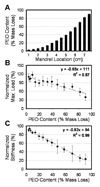The potential to improve cell infiltration in composite fiber-aligned electrospun scaffolds by the selective removal of sacrificial fibers
- PMID: 18313138
- PMCID: PMC2292637
- DOI: 10.1016/j.biomaterials.2008.01.032
The potential to improve cell infiltration in composite fiber-aligned electrospun scaffolds by the selective removal of sacrificial fibers
Abstract
Aligned electrospun scaffolds are promising tools for engineering fibrous musculoskeletal tissues, as they reproduce the mechanical anisotropy of these tissues and can direct ordered neo-tissue formation. However, these scaffolds suffer from a slow cellular infiltration rate, likely due in part to their dense fiber packing. We hypothesized that cell ingress could be expedited in scaffolds by increasing porosity, while at the same time preserving overall scaffold anisotropy. To test this hypothesis, poly(epsilon-caprolactone) (a slow-degrading polyester) and poly(ethylene oxide) (a water-soluble polymer) were co-electrospun from two separate spinnerets to form dual-polymer composite fiber-aligned scaffolds. Adjusting fabrication parameters produced aligned scaffolds with a full range of sacrificial (PEO) fiber contents. Tensile properties of scaffolds were functions of the ratio of PCL to PEO in the composite scaffolds, and were altered in a predictable fashion with removal of the PEO component. When seeded with mesenchymal stem cells (MSCs), increases in the starting sacrificial fraction (and porosity) improved cell infiltration and distribution after three weeks in culture. In pure PCL scaffolds, cells lined the scaffold periphery, while scaffolds containing >50% sacrificial PEO content had cells present throughout the scaffold. These findings indicate that cell infiltration can be expedited in dense fibrous assemblies with the removal of sacrificial fibers. This strategy may enhance in vitro and in vivo formation and maturation of functional constructs for fibrous tissue engineering.
Figures







References
-
- Lynch HA, Johannessen W, Wu JP, Jawa A, Elliott DM. Effect of fiber orientation and strain rate on the nonlinear uniaxial tensile material properties of tendon. J Biomech Eng. 2003;125(5):726–731. - PubMed
-
- Setton LA, Guilak F, Hsu EW, Vail TP. Biomechanical factors in tissue engineered meniscal repair. Clin Orthop Relat Res. 1999;(367 Suppl):S254–S272. - PubMed
-
- Holzapfel GA, Schulze-Bauer CA, Feigl G, Regitnig P. Single lamellar mechanics of the human lumbar anulus fibrosus. Biomech Model Mechanobiol. 2005;3(3):125–140. - PubMed
-
- Newman AP, Anderson DR, Daniels AU, Dales MC. Mechanics of the healed meniscus in a canine model. Am J Sports Med. 1989;17(2):164–175. - PubMed
-
- Beredjiklian PK, Favata M, Cartmell JS, Flanagan CL, Crombleholme TM, Soslowsky LJ. Regenerative versus reparative healing in tendon: a study of biomechanical and histological properties in fetal sheep. Ann Biomed Eng. 2003;31(10):1143–1152. - PubMed
Publication types
MeSH terms
Substances
Grants and funding
LinkOut - more resources
Full Text Sources
Other Literature Sources

